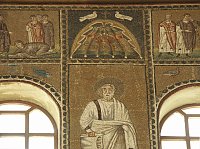

Exterior, with a portico added in the 16th centuryOriginally, this was a court church attached to the palace of the Arian King Theodoric. It was built on the western basilican plan as a three-aisled church. With the Byzantine reconquest in 540 the church was converted from Arian Christian to Orthodox use and rededicated to St. Martin, known as a foe to heretics. In the 9th century the basilica was renamed again after the relics of St. Apollinare were transferred from Sant'Apollinare in Classe. The church is outstanding for the mosaic decoration in the nave where the walls are covered in three registers. |

| |

|

|
North side, toward entrance (left) and toward apse (center)On this wall, on the lowest register, 22 female martyrs are led in a procession by the Three Magi toward the enthroned Virgin and Child. They march from Classis, the port city of Ravenna. See details--page 4. |
The south side with 26 male martyrsThese figures leave from a representation of Theodoric's palace near the entrance of the church toward the enthroned Christ near the apse. See details--page 3. Thus both streams of figures move toward the most sacred area of the church--the altar. | ||

|

|

|
Three registers of mosaics (two shown below and the lowest repeatedly photographed); Byzantine capitalThe lowest register, beneath the clerestory, depicts the male and female martyrs in procession. Between the windows, the second register depicts isolated figures of Prophets and Apostles. On the top register, above the clerestory, twenty-six panels (13 on each side) depict scenes from the life of Christ focussing on His miracles and Passion. Each panel is flanked by a repeated motif: a kind of shell-shaped niche with a tapestry surmounted by a cross flanked by two doves. | ||

|

|
Top register repeated design between narrative panels |
Middle register with large figures of prophets and Apostles |

|

|

|

|
View of nave toward apse and colum of naveThe apse has obviously been redesigned in a Baroque style. Original column are placed there however. |

|

|

|
 Click here to return to index of art historical sites.
Click here to return to index of art historical sites.
 Click here to return to index of artists and architects.
Click here to return to index of artists and architects.
 Click here to return to chronological index.
Click here to return to chronological index.
 Click here to see the home page of Bluffton University.
Click here to see the home page of Bluffton University.

